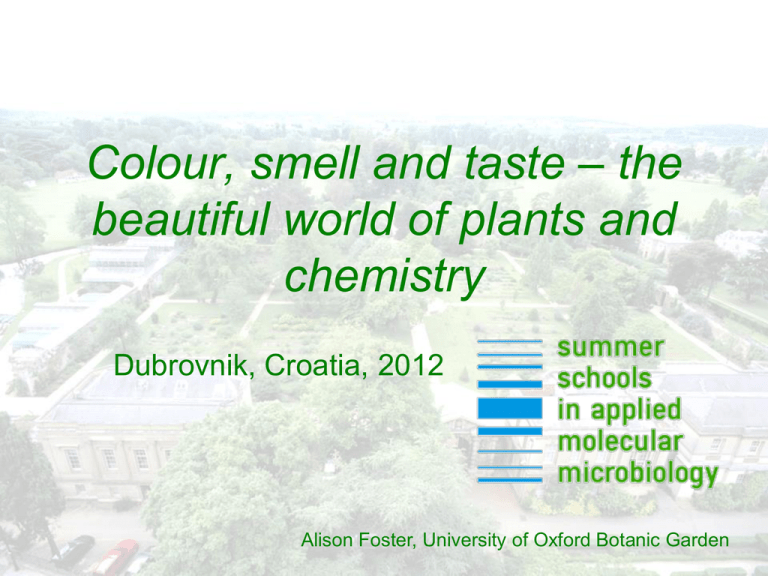Foster Guest Seminar 2
advertisement

Colour, smell and taste – the beautiful world of plants and chemistry Dubrovnik, Croatia, 2012 Alison Foster, University of Oxford Botanic Garden Plants and Chemistry • Colour • Smell • Taste Colour • Main pigment types – Porphyrins (nitrogen containing) – Flavonoids (incl. anthocyanins) – Carotenoids (terpenes) – Betalains (nitrogen containing) Colour cyanidin-3glucoside β-carotene betanidin Colour Anthocyanins: • Found in many plant families – except those in Caryophyllales • Found in all plant tissues • 109 tonnes produced per year in nature • 2% of all carbon fixed via photosynthesis is converted to anthocyanins Ferns (and Fern allies) Gymnosperms Angiosperms Colour Functions of anthocyanins: •Pollinator attractant •Sunscreen – succulents and autumn leaf colouration •Anti-feedants – bitter tasting Colour Anthocyanins as pollinator attractant? Bromeliaceae Colour Anthocyanins as sunscreen or antifeedant or both? Colour Anthocyanins as antifeedant ? Colour Metasequoia glyptostroboides dawn redwood Rhodoxanthin: Colour Daucus carrota carrot beta-carotene Colour Solanum lycopersicon tomato lycopene: Colour Betalains: •Amino-acid derived •Nitrogen containing – metabolically more expensive •Yellow to red pigments (betaxanthins and betacyanins) •Only present in plants in order Caryophyllales Caryophyllales Colour Betalains: • Caryophyllales: •Beetroot (Amaranthaceae) •Bougainvillea (Nyctaginaceae) •Pokeweed (Phytolaccaceae) •Carnations (Caryophyllaceae) Smell • Nicotiana attenuata from the SW United States – Releases benzyl acetone when flower opens at night – Attracts hawkmoth pollinators • Pollinators are also herbivores (larval stage) • Upon herbivore attack, flowers no longer produce benzyl acetone nor open at night • Day opening flowers are then hummingbird pollinated Smell • Lavandula angustifolia camphor cineole linalyl acetate linalool Smell • Amorphophallus titanum • Spadix emits smell of rotting flesh • Pollinators are attracted – Carrion-eating beetles – Flesh flies • Smell made up of amines and disulfides putrescine cadaverine Smell • Cercidiphyllum japonicum – Senescing and abscising leaves – Green leaves contain maltol glucosides – Yellow brown/fallen leaves contain maltol Taste • Chilli peppers (Capsicum species) contain capsaicin • “Hotness” measured on the Scoville scale • Test method devised in 1912 by Wilbur Scoville • Now measured by HPLC Taste • Sweet pepper 0 • Jalapeño pepper 5,000 • Scotch Bonnet 100,000 • Naga jolokia 1,040,000 Chilli pepper Scoville Heat Units Taste •Euphorbia resiniferatoxin •Resiniferatoxin 16 Billion SHU Taste • Ginger – Zingiber officinalis, Zingiberaceae • Active constituent of fresh ginger is gingerol • Cooking ginger transforms it into zingerone Taste • Ginger – Zingiber officinalis, Zingiberaceae • Dried ginger contains more of another molecule, shogaol • The Japanese name for ginger is shōga Taste • Ginger – Zingiber officinalis, Zingiberaceae • Dried ginger contains more of another molecule, shogaol • The Japanese name for ginger is shōga Taste • Vanilla– Vanilla planifolia, Orchidaceae Taste Taste O MeN O N Me O H N HN N O theophylline N Me Me N N theobromine O MeN O N Me Me N N caffeine Taste O MeN O N Me H N N theophylline O HN O N Me O Me N MeN N O theobromine N Me Me N N caffeine Conclusions








